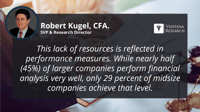We find in our recent Change in the Office of Finance benchmark research an indication of the value of using automation to execute finance department functions. Our findings reveal an increase in the use of automation by finance organizations over the past five years and a concomitant improvement in performance. For example, 46 percent of companies close their monthly books within four business days compared to 29 percent in our earlier research. Yet the glass is only half full. Finance...
Read More
Topics:
Office of Finance,
Financial Performance Management,
Price and Revenue Management,
ERP and Continuous Accounting,
robotic finance,
Predictive Planning,
revenue and lease accounting
In late February I attended Spark, the Scout annual user group meeting. This was the third and likely the last such meeting, as Scout was recently acquired by Workday. Scout’s users represent a new breed of purchasing managers and executives looking to change the role of the purchasing department. This change is critical for businesses. Saving money is the essential job of sourcing and purchasing departments. But departments can go far beyond that, helping support product and go-to-market...
Read More
Topics:
Office of Finance,
expense management,
Financial Performance Management,
Digital Technology,
Digital Commerce,
Operations & Supply Chain,
Enterprise Resource Planning,
ERP and Continuous Accounting,
purchasing,
sourcing
One of the objectives of our recent Change in the Office of Finance benchmark research was to assess the technological capabilities of finance and accounting departments. The research confirms that today we are on the verge of a major technology-led shift. Technology that’s already available can have a greater impact on how the finance department operates over the next 10 years than it has over the past 50. Advances in columnar databases, in-memory processing and artificial intelligence and ...
Read More
Topics:
Office of Finance,
Financial Performance Management,
Price and Revenue Management,
ERP and Continuous Accounting,
robotic finance,
Predictive Planning,
revenue and lease accounting,
Subscription Management
I was invited to sit on a panel at CFO 3.0 events held in San Francisco and New York hosted by Sage Intacct. This event is about the evolution of the role that started with the archetypal CFO 1.0, the green-eye-shade-wearing bean counter. Lacking usable technology, he or she was limited to keeping the books in good order and simply reporting what just happened. Today’s CFO 2.0 relies on technology developed over the past two decades as well as the broader perception of the role, catalyzed by...
Read More
Topics:
Office of Finance,
Financial Performance Management,
Price and Revenue Management,
ERP and Continuous Accounting,
robotic finance,
Predictive Planning,
revenue and lease accounting
Ventana Research recently announced its 2020 research agenda for the Office of Finance, continuing the guidance we’ve offered for nearly two decades on the practical use of technology for the finance and accounting department to help these organizations derive greater value and improve their performance. For decades organizations have discussed transforming Finance from a backward-looking “bean counter” to a more strategic advisory role — yet little has changed. One important reason is that the...
Read More
Topics:
Office of Finance,
Price and Revenue Management,
ERP and Continuous Accounting,
robotic finance,
Predictive Planning,
revenue and lease accounting
Yes, it’s an easy metaphor, but a worthwhile one to consider. For the Office of Finance, figures are its raw material. They are transformed and assembled into financial statements, forecasts and reports. Like a factory, there are blueprints (accounting standards, models and forms) that show how the parts are to be pieced together. There’s quality control in the form of internal audit. And there are final inspections — external audits — to ensure the end product has been assembled properly.
Read More
Topics:
Office of Finance,
Financial Performance Management,
Price and Revenue Management,
ERP and Continuous Accounting,
robotic finance,
Predictive Planning,
revenue and lease accounting
Sage Intacct recently hosted its annual user group meeting, Advantage, and earlier this year met with industry analysts. Both meetings shed light on how the company is addressing two key opportunities. One is building a robust offering to address rapidly evolving technology requirements for the Office of Finance. The other is broadening the scope of its offering to address the financial management and administration needs of its customers.
Read More
Topics:
Office of Finance,
business intelligence,
Financial Performance Management,
ERP and Continuous Accounting,
robotic finance,
Predictive Planning,
revenue and lease accounting,
AI and Machine Learning
For years I’ve viewed with skepticism the claim that one technology or another will reduce audit costs. For one, there’s rarely a silver bullet. An array of moving parts drive audit fees. For example, the complexity of the corporation, accounting data management and the audit staff’s familiarity with the industry and the company all affect the time auditors must spend. Also, most of the time I’ve found that achieving significant savings was not the result of going from good to great, but from...
Read More
Topics:
Office of Finance,
Analytics,
Business Intelligence,
Financial Performance Management,
ERP and Continuous Accounting,
robotic finance,
AI and Machine Learning
The traditional office of finance has five main organs: accounting keeps the books; financial planning and analysis (FP&A) analyzes performance and manages the forward-looking activities of the company such as planning, budgeting and forecasting; corporate finance raises outside money; treasury takes care of the cash and bank accounts, and tax. The modern office of finance requires a sixth: Finance IT (FIT).
Read More
Topics:
Office of Finance,
Analytics,
Financial Performance Management,
Price and Revenue Management,
Digital Technology,
Operations & Supply Chain,
ERP and Continuous Accounting,
blockchain,
robotic finance,
Predictive Planning,
Conversational Computing,
revenue and lease accounting,
collaborative computing,
Subscription Management,
AI and Machine Learning




















